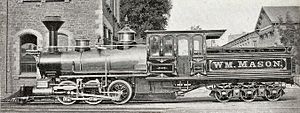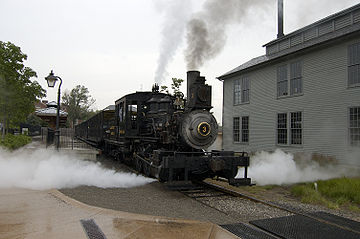- Mason Bogie
-
 The Wm. Mason, an 1874 0-6-6 Mason Bogie and the first locomotive with Walschaerts valve gear built in the United States. Note the intricate decorative work.
The Wm. Mason, an 1874 0-6-6 Mason Bogie and the first locomotive with Walschaerts valve gear built in the United States. Note the intricate decorative work.
 Boston, Revere Beach & Lynn #6, an 1886 product of Mason Machine Works. This is a 2-4-4 Mason Bogie. Note the deep firebox permitted by this configuration, and the high reversing shaft (below the bell) with long links to the valve gear die blocks.
Boston, Revere Beach & Lynn #6, an 1886 product of Mason Machine Works. This is a 2-4-4 Mason Bogie. Note the deep firebox permitted by this configuration, and the high reversing shaft (below the bell) with long links to the valve gear die blocks.
The Mason Bogie is a type of articulated steam locomotive suited for sharp curves and uneven track, once commonly used on narrow gauge lines in the United States. The design is a development of the single Fairlie, and is sometimes, and perhaps more properly known as the Mason Fairlie.
Contents
Concept and Development
The American licensee of the Fairlie Patent steam locomotive was the firm of William Mason, located in Taunton, Massachusetts. It became obvious that, for all the Fairlie locomotive's advantages, its disadvantages outweighed them. Mason developed an improved design, called the Mason-Fairlie, or more commonly the Mason Bogie (the word bogie is the British word for truck in the railroad sense). Similar locomotives developed in England were known as Single Fairlies.
Mason's idea was to remove what American railroad men saw as the biggest disadvantages of the Fairlie - its cramped space for fuel and water caused by its double ended design (not very useful on American railroads where there was always ample room for a turntable or wye), its cramped cab caused by the joined double boilers, and to some degree its poor riding.
He did this by removing one boiler of the double Fairlie and retaining only one power truck at the front. A much larger cab was fitted, and a fuel bunker and water tank behind the cab, supported by a trailing truck. The advantages of the Fairlie design were kept; the swivelling driven truck for a greater ability to negotiate curves, and the large open space between the trucks to fit a large firebox unrestricted by the wheels.
The Mason Bogie was still, though, plagued by one of the biggest problems of the Fairlie - the jointed steam pipes to the driven truck leaked far too much steam. Mason eventually changed to a different scheme, in which the pivot point for the leading truck became a hollow ball joint through which the live steam for the cylinders passed, and a sliding affair for the exhaust atop the moving cylinder saddle. Although better, this was still not great, and it also took up much valuable space in between the driving wheels, requiring Mason to use an outside valve gear, generally the Walschaerts valve gear. Additionally, to provide extra space, the reversing shaft had to be mounted atop the boiler, with long bars dropping down to the die blocks, a feature unique to Mason Bogies.
Production and Service
Approximately 146 Mason Bogies were produced by William Mason's firm between 1871 and 1890 when the firm built its last locomotive, of which 88 or so were narrow gauge units, the rest being standard gauge. This was about half the firm's total output of locomotives during this period. Major buyers included the Boston, Revere Beach & Lynn Railroad, a suburban carrier which owned 32, the Denver, South Park and Pacific Railroad, a Colorado common-carrier railroad which owned 23, and the New York and Manhattan Beach Railroad, another suburban carrier, which ran seventeen locomotives of this pattern.
The best-known locomotives were those on the Denver, South Park & Pacific, and they rostered fairly large Mason Bogies, mostly of 2-6-6 and 2-8-6 wheel arrangements, and had a lot of success with them. Even here, though, the other problem with the Fairlie design showed itself, which was the surprisingly poor tracking of the powered bogie. It would both hunt, or wander, when on straight track, yet provide more resistance to turning when it hit curvature than might be thought. This manifested itself in much greater wear on wheels and track than might have been expected.
The type had its possibly most notable success on the aforementioned Boston, Revere Beach & Lynn, which liked Mason Bogies so much that it continued to purchase them even after the closure of the William Mason factory, ordering similar locomotives from other builders as late as 1914 and operating them until electrification in 1928. It must be said, though, that the special features of the Mason Bogie weren't really used in this application, since the line was not greatly curved and did not need the flexibility the Mason Bogie bought at the cost of quite some complexity.
Surviving
At least one Mason Bogie, Torch Lake, survives, at Greenfield Village (part of The Henry Ford) in Dearborn, Michigan, an 0-6-4. It was built in 1873 and still hauls passengers during the summer months.
Similar Designs
Superficially similar to the Mason Bogie is another design, the Forney locomotive. Like the Mason Bogie, the Forney has powered axles under the boiler and a trailing truck under the rear bunker and tank behind the cab. However, the Forney's driving wheels are fixed in the frame, rather than articulated. They were reasonably popular on American narrow gauge railroads.
See also
Locomotive running and valve gear Valve gear types Allan · Baker · Bagnall-Price · Baguley · Bulleid · Caprotti · Gooch · Gresley · Joy · Kuhn slide · Lentz · Southern · Stephenson · WalschaertsBogie types Other running gear elements Adams axle · Beugniot lever · Coupled wheel · Driving wheel · Gölsdorf axle · Klien-Lindner axle · Leading wheel · Luttermöller axle · Radial axle · Trailing wheelCategories:- Articulated locomotives
Wikimedia Foundation. 2010.

